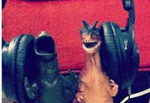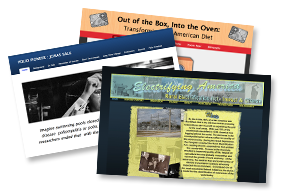Community Embraces New Word Game at Mid-Year Play Day This past Sunday, families at Takoma Park’s Seventh Annual Mid-Year Play Day had the opportunity to experience OtherWordly for the first time. Our educational language game drew curious children and parents to our table throughout the afternoon. Words in Space Several children gathered around our iPads […]
Read moreTag: art
 “Uh-oh,” Refe Tuma heard his girls whisper. “Mom and Dad are not going to like this.”
“Uh-oh,” Refe Tuma heard his girls whisper. “Mom and Dad are not going to like this.”
It’s Dinovember, and his family’s plastic dinosaurs have been getting into mischief all month. Every year, Tuma and his wife devote the month of November to “convincing our children that, while they sleep, their plastic dinosaur figures come to life. (more…)
Online courses can be a great way to teach (and learn) new skills. They can be small and highly personal, or scale to thousands of students. As followup to my post about “What is an online course?”, let’s look behind the scenes at a few kinds of successful online classes, rich with video, feedback and large amounts of real-world work.
Structuring a course
![]() The Museum of Modern Art (MoMA) currently has six 8 or 10 week online courses. The cost is $200 for self-guided courses, or $350 for instructor-led. The latter enroll 30-45 students. MoMA offers both knowledge classes, e.g., “Modern and Contemporary Art: 1945–1989,” and knowledge/skill courses, e.g., “Materials and Techniques of Postwar Abstract Painting,” in which students do hands-on work at home.
The Museum of Modern Art (MoMA) currently has six 8 or 10 week online courses. The cost is $200 for self-guided courses, or $350 for instructor-led. The latter enroll 30-45 students. MoMA offers both knowledge classes, e.g., “Modern and Contemporary Art: 1945–1989,” and knowledge/skill courses, e.g., “Materials and Techniques of Postwar Abstract Painting,” in which students do hands-on work at home.
The instructor-led classes offer structure, socialization and personalization; whereas, the self-guided courses are about individual freedom, providing access to curated articles and video, with no live instructor facilitation nor social interaction with other students.
 The studio-art offerings have weekly assignments. For example, students paint canvases using the materials and techniques of iconic artists. They photograph their works in progress and finished, and upload them to discuss with other students and the instructor. Wendy Woon directs MoMA’s education department. She feels the 10-week timeframe has worked well for studio art, allowing enough time for a sense of trust and community to develop in the discussion forums so that students are willing to have “critical conversations” criticizing each other’s work.
The studio-art offerings have weekly assignments. For example, students paint canvases using the materials and techniques of iconic artists. They photograph their works in progress and finished, and upload them to discuss with other students and the instructor. Wendy Woon directs MoMA’s education department. She feels the 10-week timeframe has worked well for studio art, allowing enough time for a sense of trust and community to develop in the discussion forums so that students are willing to have “critical conversations” criticizing each other’s work.
 There is no better way to reach underserved audiences than to drive directly to them. Mobile museums, in converted RVs or semi-trailers, are delivering history, science and art experiences. Here are two great examples.
There is no better way to reach underserved audiences than to drive directly to them. Mobile museums, in converted RVs or semi-trailers, are delivering history, science and art experiences. Here are two great examples.
History
Reaching rural audiences for $10.71 per visitor, the “Van of Enchantment” brings cultural history to schools and public events in New Mexico — at no cost to visitors. New Mexico’s rich history traces back at least 11,000 years, and includes a flourishing Pueblo community in the 13th century, Spanish conquistadors and colonists in the 16th century, and railroads in the late 19th century. (more…)
 Is the art enough? Probably not. Art museum revenues are falling and museums need to experiment with new business models and ways to build a buzz and relevance with young audiences.
Is the art enough? Probably not. Art museum revenues are falling and museums need to experiment with new business models and ways to build a buzz and relevance with young audiences.
Yesterday, art critic Judith Dobrzynski wrote in her Real Clear Arts blog about how an upcoming nighttime event at the Hirshhorn is elitist, flaunted, and inexcusable. Dobrzynski says, “I’ve said it before, but I’ll say it again, if museum officials don’t believe that art is enough, no one else will either.” What do you think? (more…)
The following were the twenty most visited art exhibitions of 2010: (more…)
 National security is a useful angle for presenting science, art and culture issues to disengaged or skeptical audiences.
National security is a useful angle for presenting science, art and culture issues to disengaged or skeptical audiences.
 Like any hook, such as sports or popular culture, military and national security themes broaden an audience for outreach. There are over 3.6M military personnel in the U.S., 1.9M spouses & kids of active duty members, and over 22M veterans, who also have families. (Stats on personnel & families, and veterans.)
Like any hook, such as sports or popular culture, military and national security themes broaden an audience for outreach. There are over 3.6M military personnel in the U.S., 1.9M spouses & kids of active duty members, and over 22M veterans, who also have families. (Stats on personnel & families, and veterans.)
There are several initiatives which are bridging the military world with the sciences and culture…
(more…)
Computers and the internet are an increasingly important way that Americans engage in the arts, says a new report from the National Endowment for the Arts. The first bar in the chart below is people consuming recorded or broadcast content:


Real life has a close competitor in the “Art Project,” released by Google last week. Their initial release is a clean, inviting site for browsing over one thousand artworks from 17 of the world’s most famous museums. At least one piece from each of the 17 museums is displayed in gigapixel resolution, so that online visitors can zoom in to the brushstrokes. Each piece also has information about the artists, text or video commentary, bios, and links to related pieces. Some museums have 3D walk-throughs, analogous to Google’s map street views (there are 6000 3D panoramas), and there’s a way to create personal art “collections” to revisit or share later.


 This weekend, I was a judge at a local chapter of
This weekend, I was a judge at a local chapter of